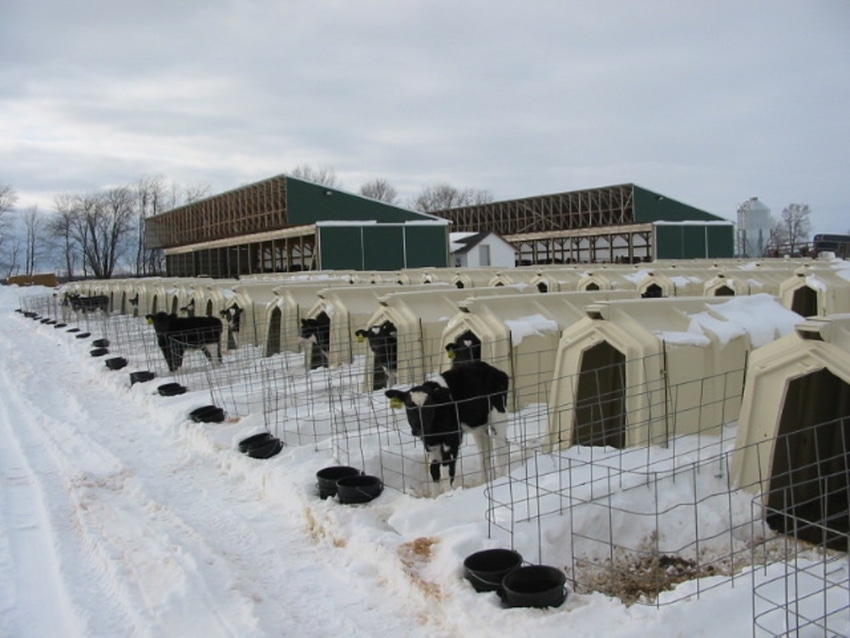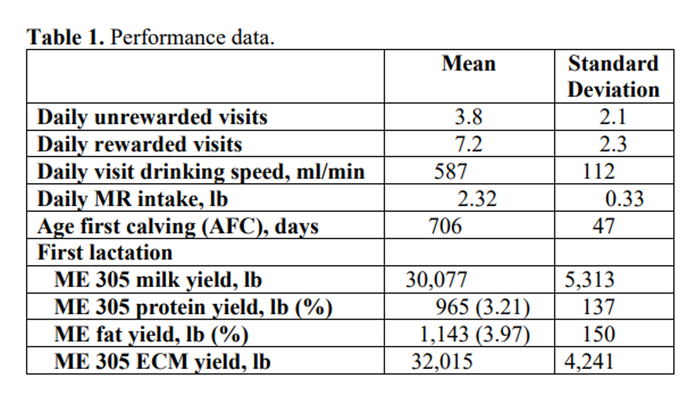Does calf feeding behavior impact future milk production?
Is milk production impacted by calf feeding behavior. Dr. Al Kertz explores the topic.
April 8, 2024

By Al Kertz, PhD, PAS, DIPL ACAN
ANDHIL LLC
The impact of calf performance and subsequent milk production was clearly established by Soberon et al. 2012. They found that for every additional lb of daily gain prior to weaning (within the range of 0.29 to 2.7 lb/day), heifers produced 850 lb more milk during their first lactation and a combined 2,280 lb for their combined first 3 lactations. That was a startling finding at that time, but other studies have also since found a similar relationship. A difficulty in in doing such studies or establishing such a relationship is the time it requires to make such measurements and the need to have large databases to establish a clear relationship. Of course, every single study can contribute to that database and relationship.
A recent study by Swartz and Petersson-Wolfe (2023) specifically addressed whether preweaning calf behavior on an automatic feeder was related to age at first calving (AFC) and subsequent milk production. Preweaning calf data were collected at the Virginia Tech Dairy from November 2014 through August 2016. Holstein calves were fed 4 liters of colostrum, and Jersey calves were fed 3 liters as soon as possible following birth. A second feeding of colostrum of similar quantity and quality was provided approximately 12 hours after the first feeding. During this study, 146 female calves (104 Holstein and 42 Jersey calves) reached maturity and reproduced for the first calving.
All calves were housed in individual hutches until they were moved into group-housing (mean age 7.8 days). While in hutches, calves were fed 2 liters of approximately 106 °F water mixed with 300 g of milk replacer (MR) twice daily. Calves were fed a 26% CP and 20% crude fat MR during the winter to offset increased energy requirements due to cold stress. Otherwise, calves were fed a 27% CP and 10% crude fat MR.
The group-housing pen used a sawdust bedded pack. Because calves were continuously added to the group and left the pen following weaning, group size was dynamic, with approximately 10 calves in the group at any given time. Calves were allowed ad libitum access to an automatic waterer and calf starter (22% CP textured) provided in a trough.
Calves were fed using an automatic calf feeder for 7 weeks, starting from the day each calf entered group housing. The automatic calf feeder gradually increased MR allowances from 900 g/day (6 liters daily) to 1,800 g/day (12 liters daily). Maximum MR allowance was reached 10 days after calves were placed onto the feeder. Weaning began 10 days before the final day on the feeder. MR allowance was gradually reduced until calves were weaned after 7 weeks (on day 49). The automatic calf feeder recorded unrewarded visits (number of visits to the feeder without a MR entitlement), rewarded visits (number of visits to the feeder with a MR entitlement), drinking speed (ml/minute), and MR intake (g). Unrewarded and rewarded visits were recorded daily, totaled over the preweaning period, and then averaged daily to provide a single value for each calf. Drinking speed and MR intake were recorded at each visit. Drinking speed was averaged across visits per day and then averaged across all days during the entire preweaning period to provide a single value for each calf. MR intake was summed across visits by day and then averaged across all days during the entire preweaning period to provide a single daily value for each calf. 2
Calves were weighed at birth using a digital scale, and these data (83 birthweights were available; 63 were missing) were entered into herd management software (PCDart, Dairy Records Management Services). Lactation records and age at first calving data were also obtained from the herd management software. Milk composition and yield were determined for individual cows at approximately monthly intervals by DHIA technicians. 
Data in Table 1 indicated:
• Unrewarded visits were nearly one-half of rewarded visits with relatively high standard deviations (SD) for both. In other words, there was much variation in these variables.
• Likewise, drinking speed SD was nearly 20% of the mean,
• Average daily MR intake of 2.32 lb is quite high for the entire preweaning period. Given the inverse relationship between MR intake and calf starter intake, it would have been good to have had starter intakes, even though they would have been group starter intakes because starter had been fed in a trough.
• AFC averaged 23.1 months with SD being about 1.5 months.
• I was surprised that the ME 305 day projection was around 30,000 lb annually since there was a mix of nearly 29% Jerseys in total first calf heifers. Mature Equivalent (ME) corrects to mature age so it would have been good to see the breakout by breeds. The SD of nearly 18% of the mean reflects this variability.
• The 3.2% milk protein and nearly 4% milk fat reflect the higher contributions to these averages by the Jerseys.

Data in Table 2 indicated that the highest correlations were between drinking speed and MR intake (0.36) and daily unrewarded visits and MR intake (0.51). Not shown is that unrewarded visits were positively associated (P < 0.01) with first-lactation ME 305 ECM (energy corrected milk), Unrewarded visits are most likely due to calves still being hungry. If so, they may then have eaten more calf starter—which was not measured. The authors acknowledged this when they said: we speculate that calves with more unrewarded visits to the automatic calf feeder may also have consumed greater amounts of grain to lessen their hunger. Potentially, calves that consume greater grain intakes during the preweaning period may also consume greater feed intakes in adulthood, subsequently enhancing milk yield.
The average daily MR intake of 2.3 lb exceeds the more moderate levels based on studies by Hill et al., 2016a,b which found that above about 1,67 lb daily dry matter MR intake could reduce subsequent intake, daily gain and digestibility following weaning. Weaning at about 2 months of age, there should be adequate starter and rumen development to minimize decreased intake and daily gain postweaning. Data from a 2018 NAHMS study (Urie et al., 2018) found post weaned daily gain was 1.3 vs 1,6 lb preweaned indicating a slump in postweaned daily gains in the US.
The Bottom Line
The lack of calf starter intake measurements in this study precluded learning whether the relationship between greater unrewarded MR visits and greater ME 305 ECM first-lactation milk production was due to compensating starter intake both pre- and post-weaning.
References
Hill, T.M., J. D. Quigley, F. X. Suarez-Mena, H. G. Bateman II, and R. L. Schlotterbeck. 2016. 2016b. Effect of milk replacer feeding rate and functional fatty acids on dairy calf performance and digestion of nutrients J. Dairy Sci. 99:6352-6361.
Hill, T. M., J. D. Quigley, H. G. Bateman II, F. X. Suarez-Mena, T. S. Dennis, and R. L. Schlotterbeck. 2016b. Effect of milk replacer program on calf performance and digestion of nutrients in dairy calves to 4 months of age. J. Dairy Sci. 99:8103-8110.
Swartz, T. H. and C. S. Petersson-Wolfe. 2023. Associations between preweaning calf feeding behaviors with age at first calving and lactational performance using an automatic calf feeder, JDS Communications 4:75–79.
Soberon, F., E. Raffrenato, R. W. Everett , and M. E. Van Amburgh, 2012. Preweaning milk replacer intake and effects on long term productivity of dairy calves. J. Dairy Sci. 95:3327- 3336.
Urie, N. J.,J. E. Lombard, C.B. Shivley, G.A. Kopral, A. E. Adams, T. J. Earleywine, J. D. Olson, and F.B. Garry. 2018. Preweaned heifer management on US dairy operations: Part I. Descriptive characteristics of preweaned heifer raising practices. J. Dairy Sci. 101:9168-9184.
You May Also Like


.png?width=300&auto=webp&quality=80&disable=upscale)
